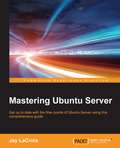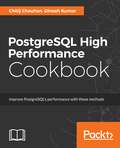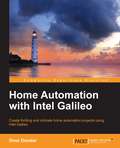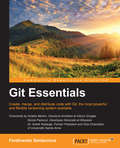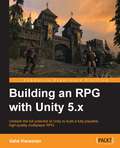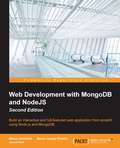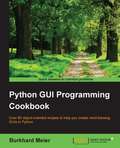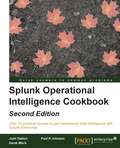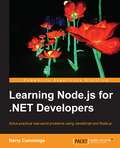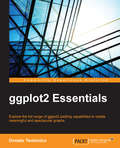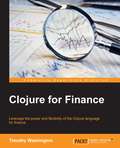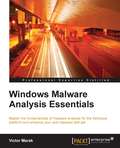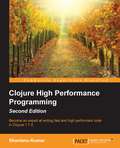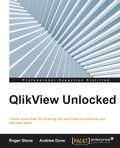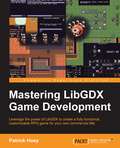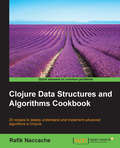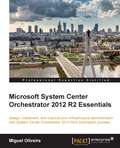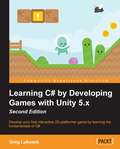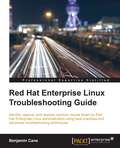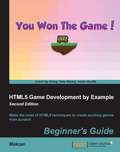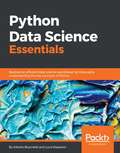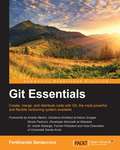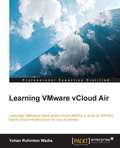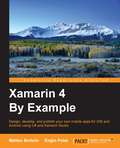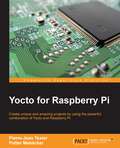- Table View
- List View
Mastering Ubuntu Server
by Jay LacroixGet up to date with the finer points of Ubuntu Server using this comprehensive guide About This Book * Get well-versed with newly-added features in Ubuntu 16.04 * Master the art of installing, managing, and troubleshooting Ubuntu Server * A practical easy-to-understand book that will help you enhance your existing skills. Who This Book Is For This book is intended for readers with intermediate or advanced-beginner skills with Linux, who would like to learn all about setting up servers with Ubuntu Server. This book assumes that the reader knows the basics of Linux, such as editing configuration files and running basic commands. What You Will Learn * Learn how to manage users, groups, and permissions * Encrypt and decrypt disks with Linux Unified Key Setup /Luks * Setup SSH for remote access, and connect it to other nodes * Understand how to add, remove, and search for packages * Use NFS and Samba to share directories with other users * Get to know techniques for managing Apache and MariaDB * Explore best practices and troubleshooting techniques In Detail Ubuntu is a Debian-based Linux operating system, and has various versions targeted at servers, desktops, phones, tablets and televisions. The Ubuntu Server Edition, also called Ubuntu Server, offers support for several common configurations, and also simplifies common Linux server deployment processes. With this book as their guide, readers will be able to configure and deploy Ubuntu Servers using Ubuntu Server 16.04, with all the skills necessary to manage real servers. The book begins with the concept of user management, group management, as well as file-system permissions. To manage your storage on Ubuntu Server systems, you will learn how to add and format storage and view disk usage. Later, you will also learn how to configure network interfaces, manage IP addresses, deploy Network Manager in order to connect to networks, and manage network interfaces. Furthermore, you will understand how to start and stop services so that you can manage running processes on Linux servers. The book will then demonstrate how to access and share files to or from Ubuntu Servers. You will learn how to create and manage databases using MariaDB and share web content with Apache. To virtualize hosts and applications, you will be shown how to set up KVM/Qemu and Docker and manage virtual machines with virt-manager. Lastly, you will explore best practices and troubleshooting techniques when working with Ubuntu Servers. By the end of the book, you will be an expert Ubuntu Server user well-versed in its advanced concepts. Style and Approach This book is an advanced guide that will show readers how to administer, manage, and deploy Ubuntu server and will also provide expert-level knowledge on advanced security and backup techniques.
PostgreSQL High Performance Cookbook
by Dinesh Kumar Chitij ChauhanGet to know effective ways to improve PostgreSQL's performance and master query optimization, and database monitoring. About This Book • Perform essential database tasks such as benchmarking the database and optimizing the server's memory usage • Learn ways to improve query performance and optimize the PostgreSQL server • Explore a wide range of high availability and replication mechanisms to build robust, highly available, scalable, and fault-tolerant PostgreSQL databases Who This Book Is For If you are a developer or administrator with limited PostgreSQL knowledge and want to develop your skills with this great open source database, then this book is ideal for you. Learning how to enhance the database performance is always an exciting topic to everyone, and this book will show you enough ways to enhance the database performance. What You Will Learn • Build replication strategies for homogeneous and heterogeneous databases • Test and build a powerful machine with multiple bench marking techniques • Get to know a few SQL injection techniques • Find out how to manage the replication using multiple tools • Benchmark the database server using multiple strategies • Work with the query processing algorithms and their internal behaviors • Build a proper plan to upgrade or migrate to PostgreSQL from other databases • See the essential database load balancing techniques and the various partitioning approaches PostgreSQL provides • Learn memory optimization techniques and database server configurations In Detail PostgreSQL is one of the most powerful and easy to use database management systems. It has strong support from the community and is being actively developed with a new release every year. PostgreSQL supports the most advanced features included in SQL standards. It also provides NoSQL capabilities and very rich data types and extensions. All of this makes PostgreSQL a very attractive solution in software systems. If you run a database, you want it to perform well and you want to be able to secure it. As the world's most advanced open source database, PostgreSQL has unique built-in ways to achieve these goals. This book will show you a multitude of ways to enhance your database's performance and give you insights into measuring and optimizing a PostgreSQL database to achieve better performance. This book is your one-stop guide to elevate your PostgreSQL knowledge to the next level. First, you'll get familiarized with essential developer/administrator concepts such as load balancing, connection pooling, and distributing connections to multiple nodes. Next, you will explore memory optimization techniques before exploring the security controls offered by PostgreSQL. Then, you will move on to the essential database/server monitoring and replication strategies with PostgreSQL. Finally, you will learn about query processing algorithms. Style and approach This comprehensive guide is packed with practical administration tasks. Each topic is explained using examples and a step-by-step approach.
Home Automation with Intel Galileo
by Onur DundarThis book is for anyone who wants to learn Intel Galileo for home automation and cross-platform software development. No knowledge of programming with Intel Galileo is assumed, but knowledge of the C programming language is essential.
Git Essentials
by Ferdinando SantacroceIf you are a software developer with little or no experience of versioning systems, or are familiar with other centralized versioning systems, then this book is for you. If you have some experience working with command lines or using Linux admin or just using Unix and want to know more about Git, then this book is ideal for you.
Building an RPG with Unity 5.x
by Vahe KaramianUnleash the full potential of Unity to build a fully playable, high-quality multiplayer RPG About This Book * Learn to build a multiplayer real-time strategy game from scratch using Unity * Gain knowledge of Unity's UI system to build complex user interfaces * See how to build and customize your framework for your RPG games Who This Book Is For If you have always wanted to create a high-end RPG using Unity, then this book is for you. Prior knowledge of game development is required and experience working with Unity will be beneficial. What You Will Learn * Construct a framework for inventory, equipment, characters, enemies, quests, and game events * See how to load and unload scenes and assets * Create multiplayer game settings for our RPG * Design a UI for user input and feedback * Enhance Game Master to handle all aspects of the RPG * Develop a custom pathfinding system * Implement AI for character and non-character players In Detail Unity is one of the most cutting-edge game engines in the world. Developers are looking for the best ways to create games of any genre in the engine. This comprehensive guide on building an RPG with Unity teaches you high-end techniques currently used in developing modern games - the tips, tricks, and techniques can be applied to your own role RPG. We begin with an introduction to, and the fundamentals of, RPG games. Moving further, you will learn the necessary parts of building an RPG, such as structuring the game environment, customizing characters, controlling the camera, and designing other attributes like inventory, weapons, and so on. We also cover designing levels of the game by adding more features to it and making the game more interesting. You will also learn how to get around the obstacle of networking in Unity and be able to implement Multi-Player mode for your RPG games. By the end of the book, you will be able to build upon core the RPG framework elements to create your own game experience. Style and approach This step-by-step tutorial will teach you how to build a multiplayer RPG. In this book you will explore the core concepts of what typical strategy one might need to build a complete game.
Web Development with MongoDB and NodeJS - Second Edition
by Jason Krol Bruno Joseph D'Mello Mithun SatheeshBuild an interactive and full-featured web application from scratch using Node.js and MongoDBAbout This BookConfigure your development environment to use Node.js and MongoDBUse Node.js to connect to a MongoDB database and perform data manipulationsA practical guide with clear instructions to design and develop a complete web application from start to finishWho This Book Is ForThis book is designed for JavaScript developers of any skill level that want to get up and running using Node.js and MongoDB to build full-featured web applications. A basic understanding of JavaScript and HTML is the only requirement for this book.What You Will LearnConfigure your development environment to use Node.js and MongoDBWrite and configure a web server using Node.js powered by the Express.js frameworkBuild dynamic HTML pages using the Handlebars template enginePersist application data using MongoDB and Mongoose ODMTest your code using automated testing tools such as the Mocha frameworkDeploy the development environment to the cloud using services such as Heroku, Amazon Web Services, and Microsoft AzureExplore Single-Page application frameworks to take your web applications to the next levelIn DetailNode.js and MongoDB are quickly becoming one of the most popular tech stacks for the web. Powered by Google's V8 engine, Node.js caters to easily building fast, scalable network applications while MongoDB is the perfect fit as a scalable, high-performance, open source NoSQL database solution. Using these two technologies together, web applications can be built quickly and easily and deployed to the cloud with very little difficulty.The book will begin by introducing you to the groundwork needed to set up the development environment. Here, you will quickly run through the steps necessary to get the main application server up and running. Then you will see how to use Node.js to connect to a MongoDB database and perform data manipulations.From here on, the book will take you through integration with third-party tools for interaction with web apps. It then moves on to show you how to use controllers and view models to generate reusable code that will reduce development time. Toward the end of the book, we will cover tests to properly execute the code and some popular frameworks for developing web applications.By the end of the book, you will have a running web application developed with MongoDB and Node.js along with it's popular frameworks.Style and approachAn easy guide to Node.js and MongoDB, which will quickly introduce you to the relevant concepts by taking you through the different steps involved in building a full-fledged web application.
Python GUI Programming Cookbook
by Burkhard A. MeierOver 80 object-oriented recipes to help you create mind-blowing GUIs in Python About This Book * Use object-oriented programming to develop amazing GUIs in Python * Create a working GUI project as a central resource for developing your Python GUIs * Packed with easy-to-follow recipes to help you develop code using the latest released version of Python Who This Book Is For If you are a Python programmer with intermediate level knowledge of GUI programming and want to learn how to create beautiful, effective, and responsive GUIs using the freely available Python GUI frameworks, this book is for you. What You Will Learn * Create amazing GUIs with Python's built-in Tkinter module * Customize the GUIs by using layout managers to arrange the GUI widgets * Advance to an object-oriented programming style using Python * Develop beautiful charts using the free Matplotlib Python module * Use threading in a networked environment to make the GUIs responsive * Discover ways to connect the GUIs to a database * Understand how unit tests can be created and internationalize the GUI * Extend the GUIs with free Python frameworks using best practices In Detail Python is a multi-domain, interpreted programming language. It is a widely used general-purpose, high-level programming language. It is often used as a scripting language because of its forgiving syntax and compatibility with a wide variety of different eco-systems. Its flexible syntax enables developers to write short scripts while at the same time, they can use object-oriented concepts to develop very large projects. Python GUI Programming Cookbook follows a task-based approach to help you create beautiful and very effective GUIs with the least amount of code necessary. This book uses the simplest programming style, using the fewest lines of code to create a GUI in Python, and then advances to using object-oriented programming in later chapters. If you are new to object-oriented programming (OOP), this book will teach you how to take advantage of the OOP coding style in the context of creating GUIs written in Python. Throughout the book, you will develop an entire GUI application, building recipe upon recipe, connecting the GUI to a database. In the later chapters, you will explore additional Python GUI frameworks, using best practices. You will also learn how to use threading to ensure your GUI doesn't go unresponsive. By the end of the book, you will be an expert in Python GUI programming to develop a common set of GUI applications. Style and approach Every recipe in this programming cookbook solves a problem you might encounter in your programming career. At the same time, most of the recipes build on each other to create an entire, real-life GUI application.
Splunk Operational Intelligence Cookbook - Second Edition
by Josh Diakun Derek Mock Paul R JohnsonOver 70 practical recipes to gain operational data intelligence with Splunk Enterprise About This Book * This is the most up-to-date book on Splunk 6.3 and teaches you how to tackle real-world operational intelligence scenarios efficiently * Get business insights using machine data using this easy-to-follow guide * Search, monitor, and analyze your operational data skillfully using this recipe-based, practical guide Who This Book Is For This book is intended for users of all levels who are looking to leverage the Splunk Enterprise platform as a valuable operational intelligence tool. The recipes provided in this book will appeal to individuals from all facets of business, IT, security, product, marketing, and many more! Also, existing users of Splunk who want to upgrade and get up and running with Splunk 6.3 will find this book invaluable. What You Will Learn * Use Splunk to gather, analyze, and report on data * Create dashboards and visualizations that make data meaningful * Build an operational intelligence application with extensive features and functionality * Enrich operational data with lookups and workflows * Model and accelerate data and perform pivot-based reporting * Build real-time, scripted, and other intelligence-driven alerts * Summarize data for longer term trending, reporting, and analysis * Integrate advanced JavaScript charts and leverage Splunk's API In Detail Splunk makes it easy for you to take control of your data, and with Splunk Operational Cookbook, you can be confident that you are taking advantage of the Big Data revolution and driving your business with the cutting edge of operational intelligence and business analytics. With more than 70 recipes that demonstrate all of Splunk's features, not only will you find quick solutions to common problems, but you'll also learn a wide range of strategies and uncover new ideas that will make you rethink what operational intelligence means to you and your organization. You'll discover recipes on data processing, searching and reporting, dashboards, and visualizations to make data shareable, communicable, and most importantly meaningful. You'll also find step-by-step demonstrations that walk you through building an operational intelligence application containing vital features essential to understanding data and to help you successfully integrate a data-driven way of thinking in your organization. Throughout the book, you'll dive deeper into Splunk, explore data models and pivots to extend your intelligence capabilities, and perform advanced searching to explore your data in even more sophisticated ways. Splunk is changing the business landscape, so make sure you're taking advantage of it. Style and approach Splunk is an excellent platform that allows you to make sense of machine data with ease. The adoption of Splunk has been huge and everyone who has gone beyond installing Splunk wants to know how to make most of it. This book will not only teach you how to use Splunk in real-world scenarios to get business insights, but will also get existing Splunk users up to date with the latest Splunk 6.3 release.
Learning Node.js for .NET Developers
by Harry CummingsSolve practical real-world problems using JavaScript and Node.js About This Book * Learn the concepts of Node.js to gain a high-level understanding of the Node.js execution model * Build an interactive web application with MongoDB and Redis and create your own JavaScript modules that work both on the client side and server side * Familiarize yourself with the new features of Node.js and JavaScript with this exclusive step-by-step guide Who This Book Is For This book is for developers who want to learn JavaScript and Node.js. Previous experience with programming is desired, but no JavaScript or Node.js knowledge is required. The book focuses mostly on web development, such as networking, serving dynamic pages, and real-time client-server communication. What You Will Learn * Understand which problems Node.js best solves * Write idiomatic JavaScript and Node.js code * Build web applications and command-line tools * Minimise complexity and efficiently solve difficult problems * Test and deploy Node.js applications * Work with persistent data * Implement real-time client-server applications * Integrate .NET and Node.js code In Detail Node.js is an open source, cross-platform runtime environment that allows you to use JavaScript to develop server-side web applications. This short guide will help you develop applications using JavaScript and Node.js, leverage your existing programming skills from .NET or Java, and make the most of these other platforms through understanding the Node.js programming model. You will learn how to build web applications and APIs in Node, discover packages in the Node.js ecosystem, test and deploy your Node.js code, and more. Finally, you will discover how to integrate Node.js and .NET code. Style and approach This is a step-by-step and practical guide to Node.js for .Net developers. It covers the fundamentals relating to typical applications. The focus is on providing the practical skills required to develop applications, with a summary of the key concepts covered.
ggplot2 Essentials
by Donato TeutonicoThis book is perfect for R programmers who are interested in learning to use ggplot2 for data visualization, from the basics up to using more advanced applications, such as faceting and grouping. Since this book will not cover the basics of R commands and objects, you should have a basic understanding of the R language.
Clojure for Finance
by Timothy WashingtonIf you're a finance professional who is currently using VBA (Excel) to perform financial calculations and quantitative analysis, and would like to use Clojure instead to improve their efficiency, then this book is for you. Basic knowledge of financial concepts is essential. Basic programming knowledge would also be an added advantage.
Windows Malware Analysis Essentials
by Victor MarakMaster the fundamentals of malware analysis for the Windows platform and enhance your anti-malware skill set About This Book * Set the baseline towards performing malware analysis on the Windows platform and how to use the tools required to deal with malware * Understand how to decipher x86 assembly code from source code inside your favourite development environment * A step-by-step based guide that reveals malware analysis from an industry insider and demystifies the process Who This Book Is For This book is best for someone who has prior experience with reverse engineering Windows executables and wants to specialize in malware analysis. The book presents the malware analysis thought process using a show-and-tell approach, and the examples included will give any analyst confidence in how to approach this task on their own the next time around. What You Will Learn * Use the positional number system for clear conception of Boolean algebra, that applies to malware research purposes * Get introduced to static and dynamic analysis methodologies and build your own malware lab * Analyse destructive malware samples from the real world (ITW) from fingerprinting and static/dynamic analysis to the final debrief * Understand different modes of linking and how to compile your own libraries from assembly code and integrate the codein your final program * Get to know about the various emulators, debuggers and their features, and sandboxes and set them up effectively depending on the required scenario * Deal with other malware vectors such as pdf and MS-Office based malware as well as scripts and shellcode In Detail Windows OS is the most used operating system in the world and hence is targeted by malware writers. There are strong ramifications if things go awry. Things will go wrong if they can, and hence we see a salvo of attacks that have continued to disrupt the normal scheme of things in our day to day lives. This book will guide you on how to use essential tools such as debuggers, disassemblers, and sandboxes to dissect malware samples. It will expose your innards and then build a report of their indicators of compromise along with detection rule sets that will enable you to help contain the outbreak when faced with such a situation. We will start with the basics of computing fundamentals such as number systems and Boolean algebra. Further, you'll learn about x86 assembly programming and its integration with high level languages such as C++.You'll understand how to decipher disassembly code obtained from the compiled source code and map it back to its original design goals. By delving into end to end analysis with real-world malware samples to solidify your understanding, you'll sharpen your technique of handling destructive malware binaries and vector mechanisms. You will also be encouraged to consider analysis lab safety measures so that there is no infection in the process. Finally, we'll have a rounded tour of various emulations, sandboxing, and debugging options so that you know what is at your disposal when you need a specific kind of weapon in order to nullify the malware. Style and approach An easy to follow, hands-on guide with descriptions and screenshots that will help you execute effective malicious software investigations and conjure up solutions creatively and confidently.
Clojure High Performance Programming - Second Edition
by Shantanu KumarBecome an expert at writing fast and high performant code in Clojure 1.7.0 About This Book * Enhance code performance by using appropriate Clojure features * Improve the efficiency of applications and plan their deployment * A hands-on guide to designing Clojure programs to get the best performance Who This Book Is For This book is intended for intermediate Clojure developers who are looking to get a good grip on achieving optimum performance. Having a basic knowledge of Java would be helpful. What You Will Learn * Identify performance issues in Clojure programs using different profiling tools * Master techniques to achieve numerical performance in Clojure * Use Criterium library to measure latency of Clojure expressions * Exploit Java features in Clojure code to enhance performance * Avoid reflection and boxing with type hints * Understand Clojure's concurrency and state-management primitives in depth * Measure and monitor performance, and understand optimization techniques In Detail Clojure treats code as data and has a macro system. It focuses on programming with immutable values and explicit progression-of-time constructs, which are intended to facilitate the development of more robust programs, particularly multithreaded ones. It is built with performance, pragmatism, and simplicity in mind. Like most general purpose languages, various Clojure features have different performance characteristics that one should know in order to write high performance code. This book shows you how to evaluate the performance implications of various Clojure abstractions, discover their underpinnings, and apply the right approach for optimum performance in real-world programs. It starts by helping you classify various use cases and the need for them with respect to performance and analysis of various performance aspects. You will also learn the performance vocabulary that experts use throughout the world and discover various Clojure data structures, abstractions, and their performance characteristics. Further, the book will guide you through enhancing performance by using Java interoperability and JVM-specific features from Clojure. It also highlights the importance of using the right concurrent data structure and Java concurrency abstractions. This book also sheds light on performance metrics for measuring, how to measure, and how to visualize and monitor the collected data. At the end of the book, you will learn to run a performance profiler, identify bottlenecks, tune performance, and refactor code to get a better performance. Style and approach An easy-to-follow guide full of real-world examples and self-sufficient code snippets that will help you get your hands dirty with high performance programming with Clojure.
QlikView Unlocked
by Roger Stone Andrew DoveUnlock more than 50 amazing tips and tricks to enhance your QlikView skillsAbout This BookLearn QlikView development best practices from the expertsDiscover valuable tips, tricks, and undocumented featuresA fast-paced guide with techniques and best practices to optimize high-performance, robust, and scalable applicationsWho This Book Is ForQlikView Unlocked is intended for anyone with at least some experience in designing, developing, or supporting QlikView applications. Whether you are new to QlikView or are a seasoned developer, there is something for everyone in this book.What You Will LearnBuild the QlikView environment correctly so that it is flexible and robustDeliver a successful QlikView projectUnderstand and implement QlikView best practicesDiscover the best way to prototype, develop, and deploy applicationsOvercome data modeling challengesExplore the in's and out's of Section AccessSolve post-deployment issues in Server and PublisherIn DetailQlikView is considered as one of the most used tool for Business Intelligence (BI). An efficient BI tool should provide five important capabilities for effective data analysis--collection (gathering important information), reporting, analysis (the ability to interact with data), visualization (the presentation of data), and discovery (exploring data). QlikView offers all these necessary skills required to deal with big data in real-world scenarios.QlikView Unlocked will provide you with new insights to get the very best from QlikView. This book will help you to develop skills to work with data efficiently. We will cover all the secrets of unleashing the full power of QlikView, which will enable you to make better use of the tool and create better results for future projects.In the course of this book, we will walk you through techniques and best practices that will enable you to be more productive. You will gain quick insights into the tool with the help of short steps called "keys," which will help you discover new features of QlikView. Moving on you will learn new techniques for data visualization, scripting, data modeling, and more. This book will then cover best practices to help you establish an efficient system with improved performance. We will also teach you some tricks that will help you speed up development processes, monitor data with dashboards, and so on.By the end of this book, you will have gained beneficial tips, tricks, and techniques to enhance the overall experience of working with QlikView.Style and approachWritten in a fairly informal style, this is a book that can be read cover-to-cover or simply used as a "how-to" reference. Using real-world examples with clear explanations, code samples, and screenshots, you will be able understand each topic fully. You will be able to apply the knowledge gained to your QlikView projects.
Mastering LibGDX Game Development
by Patrick HoeyLeverage the power of LibGDX to create a fully functional, customizable RPG game for your own commercial title About This Book * Learn game architecture and design patterns with concrete examples using proper software engineering principles * Save time and money with this handy reference guide for future game development with LibGDX * Design and develop a fully functional RPG video game from scratch with a hands on, step-by-step approach using LibGDX Who This Book Is For If you are an intermediate-level game developer who wants to create an RPG video game but found the creation process overwhelming, either by lack of tutorials or by getting lost in a sea of game-related technologies, engines, or frameworks, then this book is for you. This book assumes familiarity with Java and some basic knowledge of LibGDX. What You Will Learn * Develop characters with stat attributes, player movement, animation, physics, and collision detection * Create interactive NPC characters with speech windows and build immersion via dialog trees * Build inventory management system UIs with drag and drop items to sell, buy, and equip * Design a quest system to expand out the content of your game * Form interesting enemies with battle mechanics and spawn points * Devise scripted cutscenes to add an element of story and drama * Develop save and load game profiles * Create special effects to give the game extra "juiciness" and polish, and help build the atmosphere In Detail LibGDX is a Java-based framework developed with a heavy emphasis on performance, and includes cross-platform support out of the box (Windows, OS X, Linux, iOS, Android, and HTML5) as well as providing all the low-level functionality so that you can focus on developing your game and not battling with the platform. LibGDX also has an engaged and responsive community, active maintenance, and is available for free without a prohibitive license. Starting from the beginning, this book will take you through the entire development process of creating an RPG video game using LibGDX. First, this book will introduce you to the features specific to RPG games, as well as an overview of game architecture. Then, you will create map locations, develop character movement, add animation, integrate collision detection, and develop a portal system. Next, you will learn and develop a HUD and other UI components, as well as an inventory management system. You will then develop NPC interactions including dialog trees, shopkeepers, and quest givers. After this, you will design and create battle features for fighting enemies, as well as event triggers for world events. Finally, you will add the final polish with sound, music, and lighting effects. By the end of this book, you will have learned and applied core components from the LibGDX framework, as well as have a finished game to use as a springboard for customization and story development for your own commercial video game. Style and approach This book walks you through the concepts and implementation of developing a complete RPG game, unfolding chapter by chapter and building upon previous concepts. Each chapter can be used as an individual reference with diagrams to explain core concepts with concrete example code explained in detail.
Clojure Data Structures and Algorithms Cookbook
by Rafik Naccache25 recipes to deeply understand and implement advanced algorithms in Clojure About This Book * Explore various advanced algorithms and learn how they are used to address many real-world computing challenges * Construct elegant solutions using impressive techniques including zippers, parsing, and pattern matching * Solve complex problems by adopting innovative approaches such as logic or asynchronous programming In Detail Data-structures and algorithms often cross your path when you compress files, compile programs, access databases, or simply use your favourite text editor. Understanding and implementing them can be daunting. Curious learners and industrial developers can find these complex, especially if they focus on the detailed implementation of these data structures. Clojure is a highly pragmatic and expressive language with efficient and easy data manipulation capabilities. As such, it is great for implementing these algorithms. By abstracting away a great share of the unnecessary complexity resulting from implementation, Clojure and its contrib libraries will help you address various algorithmic challenges, making your data exploration both profitable and enjoyable. Through 25 recipes, you'll explore advanced algorithms and data-structures, well served by a sound Clojure implementation. This book opens with an exploration of alternative uses of the array data-structure, covering LZ77 compression, drawing fractals using Pascal's triangles, simulating a multi-threaded program execution, and implementing a call-stack winding and un-winding operations. The book elaborates on linked lists, showing you how to construct doubly linked ones, speed up search times over the elements of such structures, use a linked-list as the foundation of a shift-reduce parser, and implement an immutable linked-list using skew binary numbers representation. After that, the tree data-structure is explored, focusing on building self-balancing Splay Trees, designing a B-Tree backing-up an efficient key-value data-store, constructing an undo capable Rope, and showing how Tries can make for an auto-completing facility. Next, some optimization and machine learning techniques are discussed, namely for building a co-occurrence-based recommendation engine, using branch-and-bound to optimize integral cost and profit problems, using Dijkstra's algorithm to determine optimal paths and summarizing texts using the LexRank algorithm. Particular attention is given to logic programming, you will learn to use this to discover interesting relations between social website data, by designing a simple type inferencer for a mini Java-like language, and by building a simple checkers game engine. Asynchronous programming will be addressed and you will design a concurrent web-crawler, an interactive HTML5 game, and an online taxi booking platform. Finally, you'll explore advanced cases for higher order functions in Clojure while implementing a recursive descent parser using efficient mutual resucrsion, devising a mini resusable firewall simulator thanks to Clojure 1.7 new tansducers feature or building a simple unification engine with the help of Continuation Passing Style. What You Will Learn * Explore alternative uses of classical data-structures like arrays and linked-lists * Discover advanced types of tree data-structures * Explore advanced machine learning and optimization techniques * Utilise powerful Clojure libraries, such as Instaparse for parsing, core.match for pattern matching, clojure.zip for zippers, and clojure.matrix for matrix operations * Learn logic programming through the usage of the library core.logic * Master asynchronous programming using the core.async library * See the transducers in action while resolving real-world use-cases Who This Book Is For If you are an experienced Clojure developer, longing to take your knowledge to the next level by discovering and using advanced algorithms and seeing how they can be applied to real-world problems, then this book is for you.
Microsoft System Center Orchestrator 2012 R2 Essentials
by Miguel OliveiraThis book is targeted at those who want to gain time in their administrative tasks and profit from it to also improve their environment by reaching a more autonomous infrastructure.
Learning C# by Developing Games with Unity 5.x - Second Edition
by Greg LukosekDevelop your first interactive 2D platformer game by learning the fundamentals of C# About This Book * Get to grips with the fundamentals of scripting in C# with Unity * Create an awesome, 2D platformer game from scratch using the principles of object-oriented programming and coding in C# * This is a step-by-step guide to learn the fundamentals of C# scripting to develop GameObjects and master the basics of the new UI system in Unity Who This Book Is For The book is targeted at beginner level Unity developers with no programming experience. If you are a Unity developer and you wish to learn how to write C# scripts and code by creating games, then this book is for you. What You Will Learn * Understand the fundamentals of variables, methods, and code syntax in C# * Get to know about techniques to turn your game idea into working project * Use loops and collections efficiently in Unity to reduce the amount of code * Develop a game using the object-oriented programming principles * Generate infinite levels for your game * Create and code a good-looking functional UI system for your game * Publish and share your game with users In Detail Unity is a cross-platform game engine that is used to develop 2D and 3D video games. Unity 5 is the latest version, released in March 2015, and adds a real-time global illumination to the games, and its powerful new features help to improve a game's efficiency. This book will get you started with programming behaviors in C# so you can create 2D games in Unity. You will begin by installing Unity and learning about its features, followed by creating a C# script. We will then deal with topics such as unity scripting for you to understand how codes work so you can create and use C# variables and methods. Moving forward, you will find out how to create, store, and retrieve data from collection of objects. You will also develop an understanding of loops and their use, and you'll perform object-oriented programming. This will help you to turn your idea into a ready-to-code project and set up a Unity project for production. Finally, you will discover how to create the GameManager class to manage the game play loop, generate game levels, and develop a simple UI for the game. By the end of this book, you will have mastered the art of applying C# in Unity. Style and approach This is a step-by-step guide to developing a game from scratch by applying the fundamentals of C# and Unity scripting.
Red Hat Enterprise Linux Troubleshooting Guide
by Benjamin CaneIdentify, capture and resolve common issues faced by Red Hat Enterprise Linux administrators using best practices and advanced troubleshooting techniquesAbout This BookDevelop a strong understanding of the base tools available within Red Hat Enterprise Linux (RHEL) and how to utilize these tools to troubleshoot and resolve real-world issuesGain hidden tips and techniques to help you quickly detect the reason for poor network/storage performanceTroubleshoot your RHEL to isolate problems using this example-oriented guide full of real-world solutionsWho This Book Is ForIf you have a basic knowledge of Linux from administration or consultant experience and wish to add to your Red Hat Enterprise Linux troubleshooting skills, then this book is ideal for you. The ability to navigate and use basic Linux commands is expected.What You Will LearnIdentify issues that need rapid resolution against long term root cause analysisDiscover commands for testing network connectivity such as telnet, netstat, ping, ip and curlSpot performance issues with commands such as top, ps, free, iostat, and vmstatUse tcpdump for traffic analysisRepair a degraded file system and rebuild a software raidIdentify and troubleshoot hardware issues using dmesgTroubleshoot custom applications with strace and knowledge of Linux resource limitationsIn DetailRed Hat Enterprise Linux is an operating system that allows you to modernize your infrastructure, boost efficiency through virtualization, and finally prepare your data center for an open, hybrid cloud IT architecture. It provides the stability to take on today's challenges and the flexibility to adapt to tomorrow's demands.In this book, you begin with simple troubleshooting best practices and get an overview of the Linux commands used for troubleshooting. The book will cover the troubleshooting methods for web applications and services such as Apache and MySQL. Then, you will learn to identify system performance bottlenecks and troubleshoot network issues; all while learning about vital troubleshooting steps such as understanding the problem statement, establishing a hypothesis, and understanding trial, error, and documentation. Next, the book will show you how to capture and analyze network traffic, use advanced system troubleshooting tools such as strace, tcpdump & dmesg, and discover common issues with system defaults.Finally, the book will take you through a detailed root cause analysis of an unexpected reboot where you will learn to recover a downed system.Style and approachThis is an easy-to-follow guide packed with examples of real-world core Linux concepts. All the topics are presented in detail while you're performing the actual troubleshooting steps.
HTML5 Game Development by Example: Beginner's Guide - Second Edition
by MakzanThis book is for web designers who have a basic knowledge of HTML, CSS, and JavaScript and want to create Canvas or DOM-based games that run on browsers.
Python Data Science Essentials
by Luca Massaron Alberto BoschettiIf you are an aspiring data scientist and you have at least a working knowledge of data analysis and Python, this book will get you started in data science. Data analysts with experience of R or MATLAB will also find the book to be a comprehensive reference to enhance their data manipulation and machine learning skills.
Git Essentials
by Ferdinando Santacroce<P><P>Create, merge, and distribute code with Git, the most powerful and flexible versioning system available <P><P>About This Book <P><P>Master all the basic concepts of Git to protect your code and make it easier to evolve <P><P>Use Git proficiently, and learn how to resolve day-by-day tasks easily <P><P>A step-by-step guide, packed with examples to help you learn and work with Git internals <P><P>Who This Book Is For <P><P>If you are a software developer with little or no experience of versioning systems, or are familiar with other centralized versioning systems, then this book is for you. If you have some experience working with command lines or using Linux admin or just using Unix and want to know more about Git, then this book is ideal for you. <P><P>What You Will Learn <P><P>Create, branch, and merge a local repository <P><P>Transport your work to a remote repository working in a centralized manner <P><P>Organize your source code using feature branches <P><P>Organize the development flow <P><P>Get a meaningful changelog using clear commit messages <P><P>Collaborate with teammates without any impediments <P><P>Experiment with your code without affecting functional code files <P><P>Explore some tools used to migrate to Git from other versioning systems without losing your development history <P><P>Extend your knowledge of Git with some useful resources <P><P>In Detail <P><P>Since its inception, Git has attracted skilled developers due to its robust, powerful, and reliable features. Its incredibly fast branching ability transformed a piece of code from a niche tool for former Linux Kernel developers into a mainstream distributed versioning system. Like most powerful tools, Git can be hard to approach since it has a lot of commands, subcommands, and options that easily confuse newcomers. The main purpose of Git Essentials is to help you overcome this fear and become adept at all basic tasks in Git. This book starts with an introduction to version control systems, and after this you'll delve deeply into the essentials of Git. This serves as a primer for the topics to follow such as branching and merging, creating and managing a GitHub personal repository, and fork and pull requests. You will then learn the art of cherry-picking, taking only commits you like, followed by Git blame. Finally, you'll learn how to migrate from SVN using Git tools or TortoiseGit and migrate from other VCSs, concluding with a collection of resources, links, and appendices.
Learning VMware vCloud Air
by Yohan Rohinton WadiaThis book is intended for cloud engineers or administrators who wish to explore and gain hands-on experience of VMware vCloud Air.<P><P> To make the most of this book, it would be beneficial to have a bit of familiarity with basic VMware vCloud concepts, but no prior experience is required.
Xamarin 4 By Example
by Matteo Bortolu Engin PolatDesign, develop, and publish your own mobile apps for iOS and Android using C# and Xamarin Studio About This Book * Explore the exciting features of Xamarin Studio while learning to develop your own applications * Develop a complete application from conceptualization through to publishing it on the app store * The book walks you through the basics of cross-platform development with Xamarin using examples and best practices and tips for cross platform solutions. Who This Book Is For If you want to develop your own applications and want to explore the features of Xamarin Studio, then this is the book for you. It is expected that you have a basic understanding of technologies in mobile development, but prior knowledge of Xamarin is not required. What You Will Learn * Understand the software development lifecycle for mobile applications * Use Xamarin Studio and its wide range of features to write your programs in C# * Use different options to create multi-platform applications using Xamarin and develop a cross-platform extension method * Work with Xamarin forms and various UI controls * Integrate synchronous and asynchronous communication module within your app * Render images to work with Android and iOS * Link a third-party application to your solution In Detail The mobile app market is increasing exponentially every year. Xamarin Studio with its modern and powerful IDEs makes creating applications a lot easier by simplifying the development process. Xamarin will allow you and your team to create native applications by taking advantage of one of the most evolved programming language in the world: C#. This book will provide you with the basic skills you need to start developing mobile apps using C# and Xamarin. By working through the examples in each chapter, you will gain hands-on experience of creating a complete app that is fully functional by all means. Finally, you will learn to publish the app you created on the app market. Each project in this book will take you one step closer to becoming a professional app developer. Style and approach The step-by-guide will walk you through the process of creating an application of with the help of small projects that will teach you everything you need to know to build a complete application of your own.
Yocto for Raspberry Pi
by Pierre-Jean Texier Petter MabackerCreate unique and amazing projects by using the powerful combination of Yocto and Raspberry Pi About This Book * Set up and configure the Yocto Project efficiently with Raspberry Pi * Deploy multimedia applications from existing Yocto/OE layers * An easy-to-follow guide to utilize your custom recipes on your Raspberry Pi Who This Book Is For If you are a student or a developer of embedded software, embedded Linux engineer or embedded systems in competence with Raspberry Pi and want to discover the Yocto Project, then this book is for you. Experience with Yocto is not needed. What You Will Learn * Explore the basic concept of Yocto's build system and how it is organized in order to use it efficiently with Raspberry Pi * Generate your first image with Yocto for the Raspberry Pi * Understand how to customize your Linux kernel within the Yocto Project * Customize your image in order to integrate your own applications * Write your own recipes for your graphical applications * Integrate a custom layer for the Raspberry Pi In Detail The Yocto Project is a Linux Foundation workgroup, which produces tools (SDK) and processes (configuration, compilation, installation) that will enable the creation of Linux distributions for embedded software, independent of the architecture of embedded software (Raspberry Pi, i.MX6, and so on). It is a powerful build system that allows you to master your personal or professional development. This book presents you with the configuration of the Yocto Framework for the Raspberry Pi, allowing you to create amazing and innovative projects using the Yocto/OpenEmbedded eco-system. It starts with the basic introduction of Yocto's build system, and takes you through the setup and deployment steps for Yocto. It then helps you to develop an understanding of Bitbake (the task scheduler), and learn how to create a basic recipe through a GPIO application example. You can then explore the different types of Yocto recipe elements (LICENSE, FILES, SRC_URI, and so on). Next, you will learn how to customize existing recipes in Yocto/OE layers and add layers to your custom environment (qt5 for example). Style and approach A step by step guide covering the fundamentals to create amazing new projects with Raspberry Pi and Yocto.
